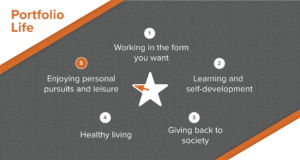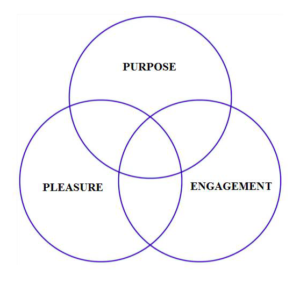Life & Work After 60… Pleasure + Engagement + Purpose
June, 2019
“Your vision will become clear only when you can look into your own heart. Who looks outside, dreams; who looks inside, awakens.” Carl Jung
For the past 70 years, most Americans have believed that enjoying personal pursuits and leisure is the principle dream of retirement. That dream persists today for most of us who are anticipating or experiencing retirement.
Ameriprise Financial did a broad study of 5,000 retirees a few years ago, and found that of the happiest retirees, about half considered themselves “carefree content.” The other half identified more fully with the label “empowered reinventer.” Which title appeals more to you?
If you are still reading this blog series, I suspect you appreciate the value of all five of the portfolio life elements listed above, and aren’t likely to be exclusively pursuing simple pleasures, or “carefree content” living in your second half.
In this blog I will be referencing the work of Richard Bolles and John Nelson, authors of What Color Is Your Parachute For Retirement? One helpful model from this book was a simple pyramid with pleasure at the base, engagement in the middle, and purpose on the top.
I agree with Bolles that these are three key factors for retirement happiness. I would, however, suggest a slightly different model that would include the same three elements, but constructed as a Venn diagram, shown below. When I have shared this updated model in recent conversations, the most common response has been, “I like this better than the pyramid, and think you should put joy in the middle of the Venn diagram.” I agree.
In this blog I will define each of these three elements. I will also share examples of each, with the goal of helping you build the personal pursuits and leisure elements for your portfolio life years.
Pleasure
What is it that represents a pleasurable activity for you? It may be watching a sporting event, going for a walk, having a conversation, watching movies or television, buying something you want, or eating out. It is about being comfortable and having fun in a relaxed and easy way. Usually the satisfaction of these activities lasts for a short period. You need to keep going back over and over to get more happiness from them.
Retirement is a time to catch up on lost leisure time. Leisure choices are often based on the things you did outside of work, usually on evenings, weekends or vacations. This includes such things as hobbies, travel, socializing, spectator events, and other entertainment. This is a counterbalance to work.
As you anticipate having more time for leisure in your future, consider crafting some experiments. As you contemplate these leisure experiments, you will find both low-stakes and high-stakes options. Be careful with the high-stakes options like vacation homes, a new RV, or buying a boat. Less risky, low-stakes, options might include renting, trying a new recreational or artistic activity, or attending classes at a community center or university.
Search your memory bank for times you enjoyed fun experiences that became displaced by work, or forgotten over time. Draw up a list of those past fun activities and describe what made them satisfying. Choose some experiments, starting with the low-stakes options.
Reach out to others who seem to be especially good at their leisure activities. They can help you get back to those things that gave you pleasure in the past, or discover interesting new possibilities to try now.
Engagement
My favorite authority on the subject of engagement is Mihaly Csikszentmihalyi, author of the book Flow. The state of flow is best described as the experiences when your abilities are well matched to a challenging task. You know you are in a state of flow when you lose track of time and are deeply involved with a project or activity in a positive way. This is not as simple as pleasure, as it challenges you and demands that you work hard at achieving results. These results often stay with you longer than pleasure, and can’t be purchased or consumed.
If the challenges are too great, anxiety may be the result. Boredom happens when the challenges are below your skill level. You are searching for the middle ground where you have interesting challenges that are a great match for your preferred skills and strengths. This may require some historical searches for clues on what have been some of your most engaging activities.
As a youth, I loved playing hockey. After taking 30 years off, I was recruited to get back on the ice. I entered an adult hockey program that helped me get back my skills and endurance. After a year of lower level play, I was matched with an intermediate level team that was a perfect match with my skills… not too hard, not too easy. This allowed me to perform at my best. I have loved playing this game for the past 15 years. At 65 I am still going strong at just the right level of play, fully engaged.
Engagement can happen when you remain open to new possibilities. Stanford psychologist John Krumbolz, who proposed the theory of “planned happenstance” says, “A satisfying career – and a satisfying life – is found through actively creating your own luck and making the most of new and unforeseen experiences.” This means you turn off the television, get out into the world, keep an open mind, and pay attention to those serendipitous opportunities that are sure to come your way.
Purpose
Purpose is defined as the use of your abilities in the service of something outside yourself, or something larger than yourself. Purpose is driven by your core values and by what you really care about in life. One of my longtime mentors, Richard Leider, authored numerous books on this subject, including his best seller, The Power of Purpose. Richard quotes these words from author E.B. White, “I arise in the morning torn between a desire to save the world and a desire to savor the world. This makes it hard to plan the day.”
Purpose requires action, not simply believing in something larger than yourself. It requires that we are aligned with our core values. As you consider what purpose to commit to, think about your family, friends, community, spiritual home, the environment, your ethnic or racial culture, a neighbor, a child needing help in school, the needy, and so on.
Contributing money to a cause you believe in, while important, won’t give you the same sense of purpose, satisfaction or happiness as working for the cause directly. When you commit yourself to advancing the cause that fits you and your values, the sense of satisfaction has the potential to last a lifetime.
Summary
This blog has explored personal pursuits and leisure, and how the combination of pleasure, engagement and purpose contribute to a happy and successful portfolio life. Pleasure is most closely related to your interests. Engagement is most closely related to your strengths. Purpose is most closely related to your values. If one of your goals is to find joy in your second half, do the math: pleasure + engagement + purpose = joy!



